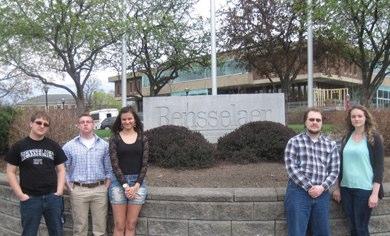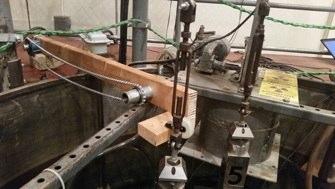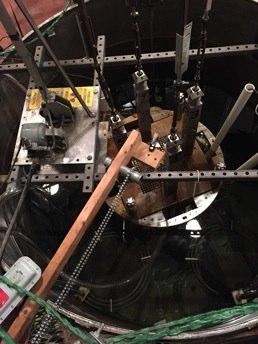The team has created a system to accurately adjust the height of a suspended LND 30573 fission detector within an empty fuel pin along the active length of the reactor fuel pins.This new method will collect data in real time at steady-state power and directly reflect the steady state neutron flux. The system consists of a gear and chain mechanism with an attached guidewire to raise the detector through the length of the empty fuel pin. The gear and chain are driven by a stepper motor hooked up to an arduino. The operator inputs the desired height into the computer in the control room, and the arduino translates that height into a number of steps for the motor to turn. The materials chosen for the design were analyzed to withstand mechanical accident scenarios using stress-strain analysis and Failure is Predicted to Occur If (F.I.P.T.O.I.) analysis. All procedures developed were required to meet 10 CFR 50.59 standards in addition to the approval of the Operations Supervisor.
Team: Emily Frantz, Rebecca Gazda, Connor LaFountain, Sean Moran, Christopher Skelton
Project Advisor: Dr. Jason Thompson

Project Motivation
Understanding the axial and radial thermal neutron flux of nuclear reactors is important for numerous reasons including fuel utilization, power generation, and safety concerns. Current methods for determining these neutron flux profiles at RPI’s Reactor Critical Facility (RCF) involve removing fuel pins and detecting the gamma-rays emitted during fission product decay. This process can expose experimenters to unnecessary gamma radiation, does not produce data related to steady state core configurations, and can not be used to measure changing conditions within the reactor. Additionally this method can not provide any absolute data regarding the power or flux profiles, only relative data. Due to these reasons it is necessary that an alternative method is created which can avoid these shortcomings.

Prototype in place in the Reactor Critical Facility core
Project Description
The team has created a system to accurately adjust the height of a suspended LND 30573 fission detector within an empty fuel pin along the active length of the reactor fuel pins.This new method will collect data in real time at steady-state power and directly reflect the steady state neutron flux. The system consists of a gear and chain mechanism with an attached guidewire to raise the detector through the length of the empty fuel pin. The gear and chain are driven by a stepper motor hooked up to an arduino. The operator inputs the desired height into the computer in the control room, and the arduino translates that height into a number of steps for the motor to turn. The materials chosen for the design were analyzed to withstand mechanical accident scenarios using stress-strain analysis and Failure is Predicted to Occur If (F.I.P.T.O.I.) analysis. All procedures developed were required to meet 10 CFR 50.59 standards in addition to the approval of the Operations Supervisor.

Prototype in place in the Reactor Critical Facility core
Results and Accomplishments
The team successfully completed the Height Adjustment Module design, a prototype, and procedures and safety analysis to accompany the design. MCNP analysis of the RCF core was conducted to determine estimates of the flux profile for each pin location. The accompanying procedures allow for students and staff to install and operate the system within the reactor. Additional experimental procedures were written to measure transient situations. The full list of procedures includes: Installation and Removal Procedure of the Detector Housing and Detector; Flux Profiling Experiment; Reactor SCRAM Transient Experiment; Loss of Moderator Transient Experiment. The transient experiments can easily be adapted to the system with the implementation of a time of flight clock. The design minimizes the radiation exposure to staff, is durable, reusable, has easily replaceable parts, and allows for regular reactor operation when in and not in use